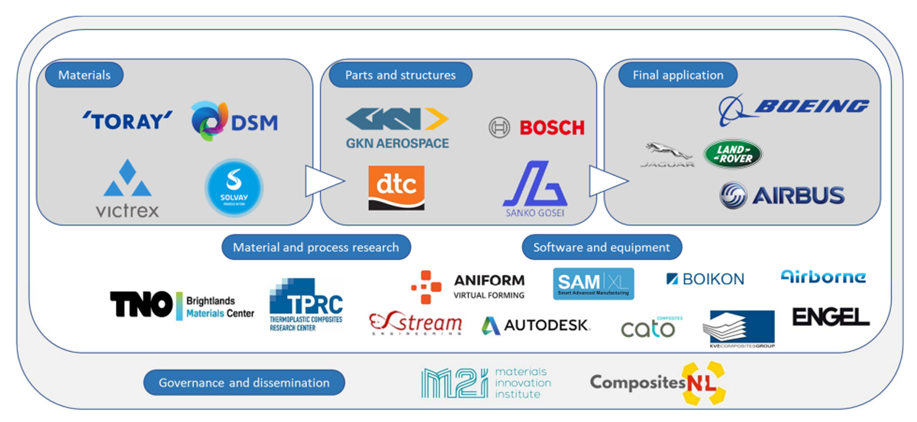Enabling Integrated Lightweight Structures In High Volumes
2022-2026

Transportation sector accounts for one-fifth of global greenhouse emissions, and reducing the weight of load-carrying structures is one key element towards more sustainable mobility. Thermoplastic composites (TPC) are best suited to the challenge, as they offer a 30% light-weighting potential, together with a good set of properties and the invaluable opportunity to be recycled. However, the integration and assembly of individual TPC parts is not at a proper level of maturity, particularly in fusion bonding.
Enlighten aims at resolving this problem by establishing the scientific principles for a physics-based joining technology, taking into account the generic process-structure-performance relations. Three fusion bonding technologies, namely induction welding, ultrasonic welding and overmoulding will be investigated at three different length scales, in order to accurately capture the mechanisms that underlie the generation of a “proper” bond.
Based on the above, the program splits up into three individual research projects.

1 Global structure evolution during fusion bonding of thermoplastic composites
Visible out of plane deformations and hidden residual thermal stresses in the assembled, final composite structure influence how well such assembly is able to withstand certain external loads. Further, the histories of temperature and strains in the material during the manufacturing cycles influence the evolution of the structure on the micro- and meso-length scale. A fast, predictive tool will be presented, giving insights on the development of temperature and stresses that arise due to different parameters and setups of the fusion bonding techniques.
2 Fibre-matrix evolution during fusion bonding processes of thermoplastic composites
The performance of fusion bonded thermoplastic composite interfaces is greatly influenced by the distribution of both matrix and fibres. These distributions are vital for performance predictions and the adoption of fusion bonded thermoplastic composite structures. This research aims to predict the fibre-matrix evolution during the entire fusion bonding process. The latter will be modelled taking into account several different effects at ‘meso’-scale level. Such effects include: deconsolidation of the material, squeeze flow behaviour, porous media flow and non-isothermal conditions, to name a few. These models will tie into the larger framework of the process structure prediction of the ENLIGHTEN project. The conditions modelled at meso-level will be used to determine deflections and residual stresses at the macro-scale. Moreover, properties of the material from the micro-scale perspective will serve as inputs for the meso-scale model.
3 Microstructure evolution during fusion bonding processes of thermoplastic composites
Performance of a polymer strongly depends on microstructural details (lamellar thickness, crystallinity and phase content) that are determined, to a great extent, by processing conditions. An in-depth understanding of the relationship between material, process and the resulting structure, both in the composite adherend and at the interphase, would allow to improve predictability and reliability of fusion bonded joints. Different kinetic mechanisms are triggered when the resin is brought to a certain range of temperatures, where molecular chain mobility is achieved, and their influence on the interface development needs to be thoroughly described. Therefore, this research aims to model the melting and crystallization kinetics in presence of a high fibre content, up to 60% by volume, within the processing time-window of a semi-crystalline polymer. Moreover, the evolving rheological properties of the melt are also indispensable, to describe the non-isothermal multiphase flow in a porous medium and also make predictions on healing.
Our Partners







